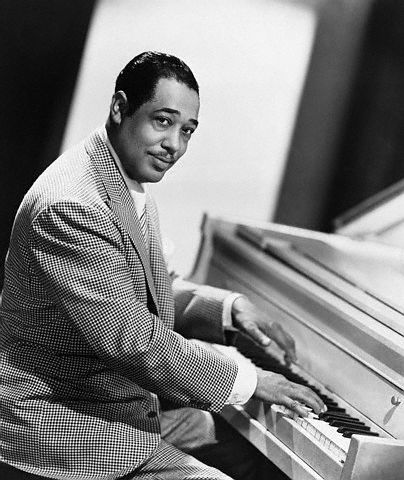Duke Ellington
Duke Ellington,is a famous American jazz composer.He is not only a composer but also a orchestrator, bandleader, and pianist. Duke is considered as one of the greatest composer in the history of jazz music and many feels that one of the greatest musicians that the 20th century has ever produced.He was born on April 29, 1899 in Washington D.C.

Ellington was always different and he personally created most of the music played by his orchestra and with his musical insight and sensitivity, he also wrote different pieces designed for specific players in his band, so that they could give their best performance.
He wrote highly personal harmonies,and he did so by concerning himself with many of the new musical forms and also by using high quality of sounds,and he is also responsible for creating a body of innovative and also original music.
More than 2000 works were composed by Ellington and this includes
i)Musical comedies
ii)Music for ballet and motion pictures
iii)An opera and
iv)Numerous short songs and instrumentals.
He was also responsible for composing for his jazz big band with the help of players who had very distinct musical styles. He toured with his group form 1930s till the remainder of his career.
Estimated reports says that during his tour he had travelled about 1.6 crore km and also staged about more than 20,000 performances throughout the United States and in 65 other nations around the world.
Ellington was born as Edward Kennedy Ellington in Washington, D.C.. He was nor born rich as he was born into a middle-class family.The nickname Duke was acquired by him when he was a child for his manners, clothing, and personality.
Ellington parents had musical backgrounds, and this was a great motivation for Ellington as he started to play piano in a musical style called as ragtime, when he was a teenager.When he was young he started playing for his friends and also at the parties and he slowly became popular and soon he formed a small dance band under the name "The Duke's Serenaders".
Ellington moved to New York City in 1923, and he was also in hunt for musicians who are capable for contributing special sounds to his band and one of the specialists he found was an American trumpeter called as James “Bubber” Miley,who was a specialist in creating uniques sounds and he was able to achieve this through the use of mutes (i.e,sound-altering devices).
It was Jammes who helped to transform Ellington's combo from a polite society band into a respected jazz group.The turning point for Ellington was in 1927 when he started to perform at the Cotton Club, which is considered as one of the most prominent nightclub in the Harlem area of New York City at the time.
It was in late 1920s Ellington composed for and recorded with his 12-member orchestra such pieces as
i)“Black and Tan Fantasy” in 1927
ii)“The Mooche” in 1928 and
iii)“Mood Indigo” in 1930.
Through these recordings and also through radio broadcasts from the Cotton Club, Ellington gained a national and
international reputation. In 1931 he took his band on its first tour of the United States.
His work “It Don't Mean a Thing ”, which was released in 1932,expected swing music and dancing to become a national obsession in the United States.So he enlarged his orchestra to 14 members after 1932, and in 1939 he hired a gifted young American arranger, Billy Strayhorn,who later became his musical collaborator.

Billy also wrote one of the Ellington orchestra's signature tunes,i.e., “Take the ‘A’ Train” which was released on
1941.Ellington's band included some of the best American jazz instrumentalists in the year 1940 and it includes
i)Saxophonists Ben Webster and Johnny Hodges
ii)Trombonists Lawrence Brown and Joseph “Tricky Sam” Nanton
iii)Trumpeters Rex Stewart and Cootie Williams and
iv)Bassist Jimmy Blanton.
At the beginning of the 1940s Ellington orchestra made some brilliant recordings and these includes
#)“Ko-Ko” in 1940 and
#)“Concerto for Cootie” in 1940
#)“Dusk” in 1940
#)“Cotton Tail” in 1940
#)“Moon Mist” in 1941and
#)“Main Stem” in 1942
For the first time they performed at at New York City's Carnegie Hall,which is a prestigious musical venue,in 1943,and and their performance includes "Black, Brown, and Beige", and this is considered as one of Ellington's longest and most ambitious compositions.

But after this performance they regularly played at Carnegie Hall more every year until 1952. During the late 1940s Ellington's band, they experienced a higher rate of turnover among musicians and went into creative and commercial decline.
At this time the band crew was increased to 18 members,and now it is considered a standard size for a jazz big band.
His most enduring work as a pianist is the album called Piano Reflections which was released in 1953.After this album he earned critical success with recordings of suites, composed for concerts and records,which includes
#)A Drum Is a Woman in 1956
#)Such Sweet Thunder in 1958
#)The Far East Suite in 1966
#)Anatomy of a Murder (in 1959 .
As Ellington was a religious man,from 1960's he started composing liturgical works and he called this as sacred concerts Ellington also received 11 Grammy Awards and 19 honorary doctorate degrees during his career and he was also awarded the Presidential Medal of Freedom by the United States in 1969 and in 1973 the Legion of Honor by France.
The Smithsonian Institution in Washington, D.C., acquired his entire archive in 1988,which contained about 200,000 pages of unpublished music and other documents and they made it available to researchers, musicians, and the general public.
He eventually died on May 24, 1974 at the age of 75 in New York.
Like it on Facebook, Tweet it or share this article on other bookmarking websites.

